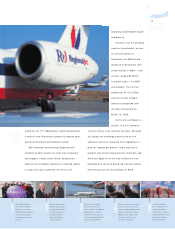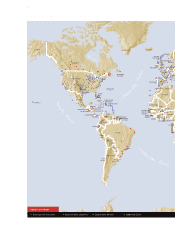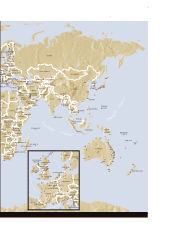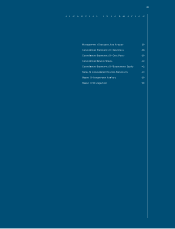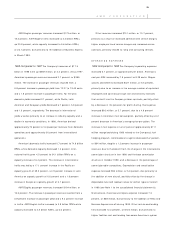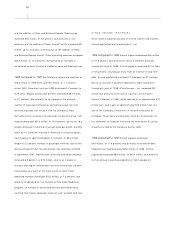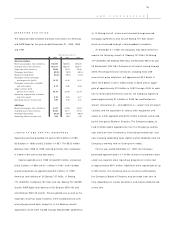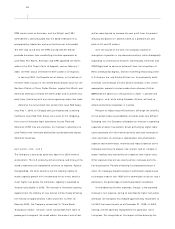American Airlines 1999 Annual Report Download - page 30
Download and view the complete annual report
Please find page 30 of the 1999 American Airlines annual report below. You can navigate through the pages in the report by either clicking on the pages listed below, or by using the keyword search tool below to find specific information within the annual report.
AMR CORPORATION
29
AMR Eagle’s passenger revenues increased $173 million, or
15.4 percent. AMR Eagle’s traffic increased to 3.4 billion RPM s,
up 20.9 percent, while capacity increased to 5.6 billion ASMs,
or 26.1 percent, due primarily to the addition of Business Express
in March 1999.
1998 Compared to 1997 The Company’s revenues of $17.5
billion in 1998 were up $559 million, or 3.3 percent, versus 1997.
American’s passenger revenues increased 2.7 percent, or $385
million. The increase in passenger revenues resulted from a
0.9 percent increase in passenger yield from 13.37 to 13.49 cents,
and a 1.8 percent increase in passenger traffic. For the year,
domestic yields increased 3.1 percent, while Pacific, Latin
American and European yields decreased 6.7 percent, 5.8 percent
and 1.0 percent, respectively. The decrease in international
yields was due primarily to an increase in industry capacity and a
decline in economic conditions. In 1998, American derived
approximately 70 percent of its passenger revenues from domestic
operations and approximately 30 percent from international
operations.
American’s domestic traffic increased 0.7 percent to 74.9 billion
RPMs, while domestic capacity decreased 1.4 percent. Inter-
national traffic grew 4.3 percent to 34.1 billion RPMs on a
capacity increase of 6.4 percent. The increase in international
traffic was led by a 17.1 percent increase in the Pacific on
capacity growth of 29.3 percent, a 4.9 percent increase in Latin
America on capacity growth of 6.6 percent and a 1.8 percent
increase in Europe on capacity growth of 2.7 percent.
AMR Eagle’s passenger revenues increased $104 million, or
10.2 percent. The increase in passenger revenues resulted from a
0.9 percent increase in passenger yield and a 9.2 percent increase
in traffic. AMR Eagle’s traffic increased to 2.8 billion RPM s while
capacity increased to 4.5 billion ASMs, up 6.0 percent.
Other revenues increased $101 million, or 10.7 percent,
primarily as a result of increased administrative service charges,
higher employee travel service charges and increased service
contracts, primarily related to ramp and consulting services.
OPERATING EXPENSES
1999 Compared to 1998 The Company’s operating expenses
increased 6.7 percent, or approximately $1 billion. American’s
cost per ASM increased by 1.5 percent to 9.39 cents. Wages,
salaries and benefits increased $327 million, or 5.6 percent,
primarily due to an increase in the average number of equivalent
employees and contractual wage rate and seniority increases
that are built into the Company’s labor contracts, partially offset
by a decrease in the provision for profit-sharing. Fuel expense
increased $92 million, or 5.7 percent, due to a 4.6 percent
increase in American’s fuel consumption, partially offset by a 0.2
percent decrease in American’s average price per gallon. The
increase in fuel expense is net of gains of approximately $111
million recognized during 1999 related to the Company’s fuel
hedging program. Commissions to agents decreased 5.2 percent,
or $64 million, despite a 1.2 percent increase in passenger
revenues, due to the benefit from the changes in the international
commission structure in late 1998 and the base commission
structure in October 1999, and a decrease in the percentage of
commissionable transactions. Depreciation and amortization
expense increased $52 million, or 5.0 percent, due primarily to
the addition of new aircraft, partially offset by the change in
depreciable lives and residual values for certain types of aircraft
in 1999 (see Note 1 to the consolidated financial statements).
Maintenance, materials and repairs expense increased 7.3
percent, or $68 million, due primarily to the addition of Reno and
Business Express aircraft during 1999. Other rentals and landing
fees increased 12.3 percent, or $103 million, due primarily to
higher facilities rent and landing fees across American’s system





